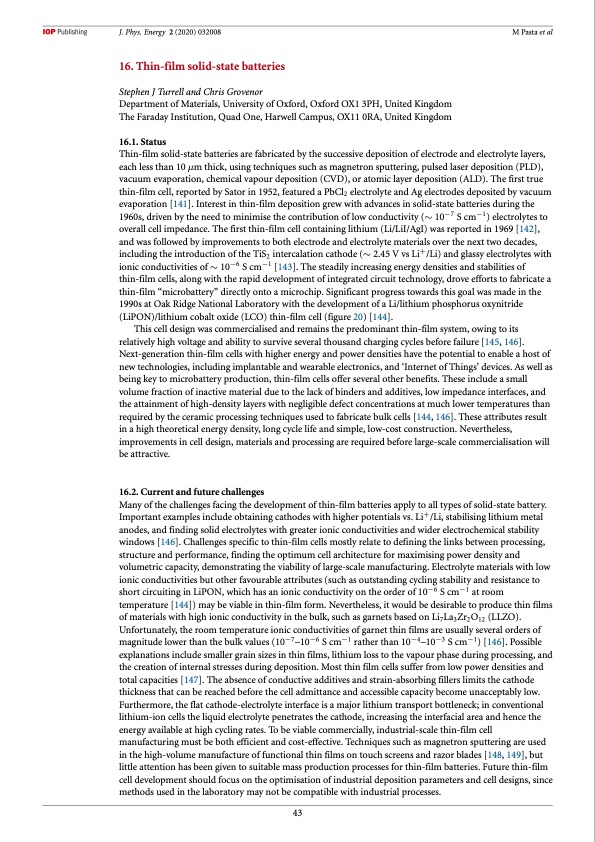
PDF Publication Title:
Text from PDF Page: 044
J. Phys. Energy 2 (2020) 032008 M Pasta et al 16. Thin-film solid-state batteries Stephen J Turrell and Chris Grovenor Department of Materials, University of Oxford, Oxford OX1 3PH, United Kingdom The Faraday Institution, Quad One, Harwell Campus, OX11 0RA, United Kingdom 16.1. Status Thin-film solid-state batteries are fabricated by the successive deposition of electrode and electrolyte layers, each less than 10 μm thick, using techniques such as magnetron sputtering, pulsed laser deposition (PLD), vacuum evaporation, chemical vapour deposition (CVD), or atomic layer deposition (ALD). The first true thin-film cell, reported by Sator in 1952, featured a PbCl2 electrolyte and Ag electrodes deposited by vacuum evaporation [141]. Interest in thin-film deposition grew with advances in solid-state batteries during the 1960s, driven by the need to minimise the contribution of low conductivity (∼ 10−7 S cm−1) electrolytes to overall cell impedance. The first thin-film cell containing lithium (Li/LiI/AgI) was reported in 1969 [142], and was followed by improvements to both electrode and electrolyte materials over the next two decades, including the introduction of the TiS2 intercalation cathode (∼ 2.45 V vs Li+/Li) and glassy electrolytes with ionic conductivities of ∼ 10−6 S cm−1 [143]. The steadily increasing energy densities and stabilities of thin-film cells, along with the rapid development of integrated circuit technology, drove efforts to fabricate a thin-film “microbattery” directly onto a microchip. Significant progress towards this goal was made in the 1990s at Oak Ridge National Laboratory with the development of a Li/lithium phosphorus oxynitride (LiPON)/lithium cobalt oxide (LCO) thin-film cell (figure 20) [144]. This cell design was commercialised and remains the predominant thin-film system, owing to its relatively high voltage and ability to survive several thousand charging cycles before failure [145, 146]. Next-generation thin-film cells with higher energy and power densities have the potential to enable a host of new technologies, including implantable and wearable electronics, and ‘Internet of Things’ devices. As well as being key to microbattery production, thin-film cells offer several other benefits. These include a small volume fraction of inactive material due to the lack of binders and additives, low impedance interfaces, and the attainment of high-density layers with negligible defect concentrations at much lower temperatures than required by the ceramic processing techniques used to fabricate bulk cells [144, 146]. These attributes result in a high theoretical energy density, long cycle life and simple, low-cost construction. Nevertheless, improvements in cell design, materials and processing are required before large-scale commercialisation will be attractive. 16.2. Current and future challenges Many of the challenges facing the development of thin-film batteries apply to all types of solid-state battery. Important examples include obtaining cathodes with higher potentials vs. Li+/Li, stabilising lithium metal anodes, and finding solid electrolytes with greater ionic conductivities and wider electrochemical stability windows [146]. Challenges specific to thin-film cells mostly relate to defining the links between processing, structure and performance, finding the optimum cell architecture for maximising power density and volumetric capacity, demonstrating the viability of large-scale manufacturing. Electrolyte materials with low ionic conductivities but other favourable attributes (such as outstanding cycling stability and resistance to short circuiting in LiPON, which has an ionic conductivity on the order of 10−6 S cm−1 at room temperature [144]) may be viable in thin-film form. Nevertheless, it would be desirable to produce thin films of materials with high ionic conductivity in the bulk, such as garnets based on Li7La3Zr2O12 (LLZO). Unfortunately, the room temperature ionic conductivities of garnet thin films are usually several orders of magnitude lower than the bulk values (10−7–10−6 S cm−1 rather than 10−4–10−3 S cm−1) [146]. Possible explanations include smaller grain sizes in thin films, lithium loss to the vapour phase during processing, and the creation of internal stresses during deposition. Most thin film cells suffer from low power densities and total capacities [147]. The absence of conductive additives and strain-absorbing fillers limits the cathode thickness that can be reached before the cell admittance and accessible capacity become unacceptably low. Furthermore, the flat cathode-electrolyte interface is a major lithium transport bottleneck; in conventional lithium-ion cells the liquid electrolyte penetrates the cathode, increasing the interfacial area and hence the energy available at high cycling rates. To be viable commercially, industrial-scale thin-film cell manufacturing must be both efficient and cost-effective. Techniques such as magnetron sputtering are used in the high-volume manufacture of functional thin films on touch screens and razor blades [148, 149], but little attention has been given to suitable mass production processes for thin-film batteries. Future thin-film cell development should focus on the optimisation of industrial deposition parameters and cell designs, since methods used in the laboratory may not be compatible with industrial processes. 43PDF Image | 2020 roadmap on solid-state batteries

PDF Search Title:
2020 roadmap on solid-state batteriesOriginal File Name Searched:
Pasta_2020_J_Phys_Energy_2_032008.pdfDIY PDF Search: Google It | Yahoo | Bing
Sulfur Deposition on Carbon Nanofibers using Supercritical CO2 Sulfur Deposition on Carbon Nanofibers using Supercritical CO2. Gamma sulfur also known as mother of pearl sulfur and nacreous sulfur... More Info
CO2 Organic Rankine Cycle Experimenter Platform The supercritical CO2 phase change system is both a heat pump and organic rankine cycle which can be used for those purposes and as a supercritical extractor for advanced subcritical and supercritical extraction technology. Uses include producing nanoparticles, precious metal CO2 extraction, lithium battery recycling, and other applications... More Info
| CONTACT TEL: 608-238-6001 Email: greg@infinityturbine.com | RSS | AMP |